See links below for my overview of paddles. I did this back in 2010 however, I just added the lastest Stellar wing paddle to the text below. Since this posting I have added two other single Jantex Gamma’s to go with my Jantex two piece. I still have 2 Onno’s but have sold all other brands. I will add later pics of the Stellar and Jantex paddles.
Pictures of Older Paddles
YouTube Link of my Review
Over the years I have managed to accumulate almost as many paddles as I have surfskis. Bearing extensive collections of both, I thought it might be informative to do a paddle review to accompany the surfski review matrix. I do 99% of my paddling in the ocean, so this quick review is geared toward those paddles that fare better in the ocean, versus those intended for primarily flat water paddling.
Like surfskis, you may think there is not much difference in paddles; however, every paddle has a unique feel, just as surfskis do. You maybe able to make some predictions of paddle feel based on blade shape, blade size, twist, length, leading edge, etc, but ultimately you need to try it one or two times in the ocean to see how you like it. This is especially true of flatwater paddles that have varying degrees of twist. They may feel great in benign conditions, but in the ocean this twist can easily become a liability.
In his clip, Lloyd explains the twist of a paddle. This often can explain what I call the ‘forgiveness’ of a paddle, and how it impacts its feel, a major consideration when choosing a paddle for ocean use. By ‘forgiveness’, I mean to describe those characteristics that enable the paddler to efficiently transfer power, without requiring the textbook form that may be difficult, if well nigh impossible, to consistently display in the rough and tumble of ocean conditions. This is not to say you cannot acclimate to using a more technical paddle, as many people have. However, if you keep an open mind and are not a stuck in a purist rut, a more forgiving paddle may require less effort, increase your stability, and give you more confidence in bigger conditions. Win/win/win.
A number of years ago in the Blackburn Challenge, I used my Quickblade Proton in lieu of my Epic Mid, because it was super light and had a slightly smaller blade. Although I was in my S1R at the time, I felt more unstable in the remaining five miles of the 20 mile race than I thought I should have. I dismissed it as fatigue and thought little of it until a month later when a light bulb went off that it could conceivably have been my paddle itself that was making me feel unstable in the bigger conditions and not my boat, or level of fatigue. Even though the Proton was super light, it was a more technical paddle, so as I became tired and the conditions got bigger, my stroke was not as precise, leading to my feeling of instability.
A short time later, I purchased another Epic Mid. This time it was maroon shaft that was light, adjustable, and extremely forgiving. I now no longer had to trade off lightness for forgiveness. Like my surfski purchases, it was trial and error to find suitable racing paddle that would meet my ocean racing needs.
Now, many years later, I have owned many wing paddles, including 6 Epics, 4 Onno’s, 4 Braca-sport’s, 1 Quickblade, 1 Lendal Kinetic Wing, and 1 Jantex. For this review, I was shipped three demo paddles: one from Epic and two from Maxpaddles. After all the paddle purchases and countless borrowing of other people’s paddles, I consider a few key areas when I test a paddle.
First, as noted, is how forgiving the paddle is. You want a paddle that you don’t have to plant the blade perfectly on each stroke to have a nice, smooth, and predictable catch. In the ocean you are constantly adjusting to the movements of the sea, unlike flatwater paddling where you can concentrate fully on planting the blade squarely on each stroke. Most of the paddles in this review allow for an imperfect stroke without negatively affecting stability on the catch and exit.
Second, is blade size. Do not underestimate blade size. A blade that is too big for you can drastically decrease your racing performance. About three years ago, I purchased an Onno Mid and used it for only the second time before racing it in the Essex River Race. Mistake! After 2 miles on the 6 mile course I was exhausted. Why? The blade was too big for me at this point in my fitness and skill level, even as a strong paddler. You need to ascertain how strong of a paddler you are and make the appropriate choice in blade size. The bigger the blade, the more effort it takes to move it through the water. Bigger guys, very strong paddlers, can use a bigger blade. Most of us use a mid size blade or small mid in most brands.
Another factor is weight. Most paddles come in between 19-28 ounces. You may not think a few ounces in weight can make a difference. It does when racing. A lighter paddle allows for a quicker turnover to catch a bump, requires less energy to hold up, and facilitates a more even stroke rate over long events. Imagine a stroke rate of 75-90 per strokes per minute with a paddle that is four ounces heavier. Over a three hour race, you can quickly surmise how these four ounces add to your workload.
Over the last few years, adjustable paddles have become the norm. You can adjust the length and the angle, and transporting them is much easier, as is resale. However, they can be a source of great frustration. If the ferrule works improperly, gets corroded, is over tightened, or freezes stuck, it can turn a reasonable person homicidal. Fortunately, over the years, most ferrules have improved. Perhaps the best I have seen is the Quick Lock Lever used on the Onno, and some Jantex paddles.
While some paddles are more forgiving on the catch, some are more forgiving on the exit; important in ocean paddling. Most of us can probably trace a capsize on the exit of a stroke, since it is at this point we are most vulnerable, with little support from the paddle. So if your paddle catches on the exit, or hangs up as you’re trying to brace or while doing a quick recovery stroke, this can increase your instability and lead to unwanted swims.
Another consideration, depending on paddler preference, is the firmness of the catch upon entry. Some paddlers prefer a firm catch, while others prefer a softer catch. Additionally, some paddles apportion power throughout the stroke, while others are designed with most of the power coming from a powerful catch with less resistance as you transition to the exit.
Lastly, there are some differences in shaft stiffness. A more compliant paddle can be less jarring and easier on the joints as compared to a very stiff shaft. Some shafts are round while others are oval, and some are more slip resistant than others.
In summary, how forgiving a paddle is on the catch and exit is paramount, coupled to blade size, firmness of catch, stiffness of shaft, weight, and how easy and reliable the ferrule is.
Below, I briefly outlined the pro and cons of the various paddles in my quiver. I have used Epic paddles for 9 years, Onno paddles for 2, Braca paddles off and on for about 4, Quickblade Proton for 2 years, Jantex for 8 months, and Max paddles for 2 months.
1. Onno Small Mid, carbon Foam– very forgiving, smooth catch and very clean exit, flex in blades offsets stiff shaft,
super light(21.2 ounces), blades not as durable as full carbon blades, round non slip shaft, quick lock lever is secure, quick, and reliable.
2. Onno Small Mid, full carbon– very forgiving, smooth catch and very clean exit, blades are stiffer than foam blades, stiff shaft, very light (24.2 ounces), round non slip shaft, quick lock lever is secure, fast, and reliable.
3. Jantex Gamma Mid– most forgiving, clean catch and extremely clean exit, power transfer throughout stroke, round non slip shaft, (25.8 ounces) with weight noticeable in blade that adds to swing weight of paddle, durable, quick lock lever is secure, fast, and reliable. Once I weighed Jantex Paddle it was not the heaviest paddle in the review as I mentioned in the video portion, however the swing weight was more noticeable with the Jantex than the other paddles. *Note: My Jantex has the quick lever lock, while most have different ferrule depending who you buy from. This paddles move in a straighter line as it moves through stroke compared to other paddles.
4. Epic Mid, blue shaft– forgiving on both catch and exit, stiffer shaft than maroon, durable, slightly heavier than maroon shaft (25.5 ounces You must keep older ferrules in working order, do not over tighten, rinse frequently and separate after each training session. Older ferrules can get stuck. Newer ferrules are better but you must check them. Oval shaft can be slippery.
5. Epic Mid, maroon shaft– forgiving catch and exit, shaft is more flexible than blue, durable, oval shaft, light (23.4 ounces); you must keep older ferrules in working order, do not over tighten, rinse frequently and separate after each training session. Older ferrules can get stuck often. New ferrules are better, but you must check them.
6. Epic Small Mid, maroon shaft– very forgiving and light, due to smaller blade size. Some strong paddlers even prefer this size over mid for this reason and for longer races. Improved lever ferrule on the newer models. (forgot to weigh it before I sent back to Epic).
7. Braca VI 765– less forgiving, very firm catch, largest carbon wing blade reviewed, typically used in flatwater shorter distances for stronger paddlers. Extremely clean exit, round shaft, easy to remove blades if necessary, single shaft weight 216 cm, 29.3 ounces. Braca just released metal lever lock that works well.
8. Braca IV 735– more forgiving than the 7, perhaps easiest Braca wing paddle to learn on, clean exit, most used Braca surfski wing paddle in ocean, durable plastic or metal connectors available, round shaft, easy to remove blades if necessary. Braca’s use a high quality metal or plastic lever lock for rapid adjustment of length and angle.
Note: the New Braca XI Van Dusen ’92 is now on par with the IV as one of the most popular Braca surfski and sprint paddles in the world, but was not on the market by Braca at the time of this article. Blade sizes from 675 to 815, in stock, with 705/735 most popular.
9. Braca VII 745– less forgiving wing paddle, need to have clean catch, if have good technique has softer feel, power is early on and swings wide, clean exit, durable, round shaft, easy to remove blades if necessary, weight 25.8 ounces (single shaft)
10. Braca VIII 767– very forgiving in flat to moderate seas, in larger seas, long blade gets caught on exit, power transfer through stroke, smooth catch and exit, round shaft, easy to remove blades if necessary.
11. Max 3– Tear drop, less forgiving, catch needs to be fairly clean, smaller blade may be too small for some stronger paddlers, round shaft, twist ferrule, do not over tighten, rinse frequently and separate after each training session, good value for price.
12. Max 357– very large blade for very strong paddlers, good degree of twist, clean exit, high degree of twist, weight 28.9 ounces, twist ferrule, good value for price, Chris has been enjoying this paddle for his under 10 mile ski sessions.
13. Quickblade Proton– super light, less forgiving, firm catch, catch needs to be fairly clean, smaller blade may be too small for some stronger paddlers, round shaft, can adjust 2 centimeters in length, angle fixed, pin holds shaft together so you must tape pin to secure.
14. Stellar Small Mid– Very forgiving, almost no twist therefore very easy to use for all skill level of paddlers. Suitable for fit paddlers who want a slightly faster stroke rate like myself or for endurance races over 90 minutes where a slightly smaller blade could be preferable. For the past 2 years I have been using a Jantex Gamma either a two piece or a single averaging 80-85 strokes per minute. I found with this blade I am at 90-95. Power generated slightly more at catch and less on the last part of stroke. The ferrule is a cam lock unlike all the other paddles in this review therefore no slippage. This paddle is all carbon and weighs 24 oz.
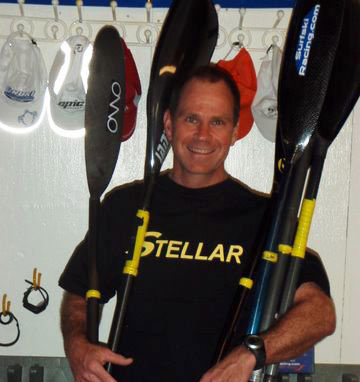
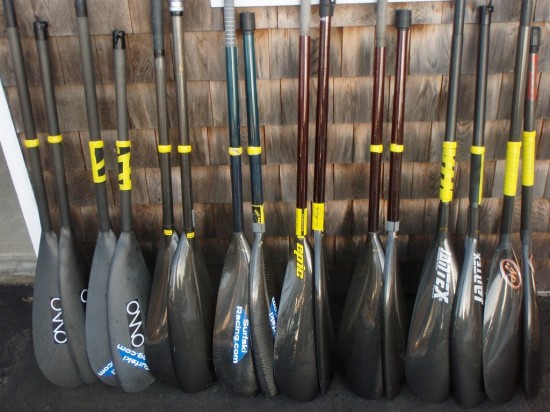
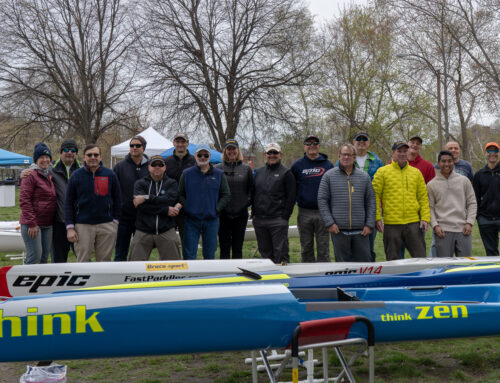
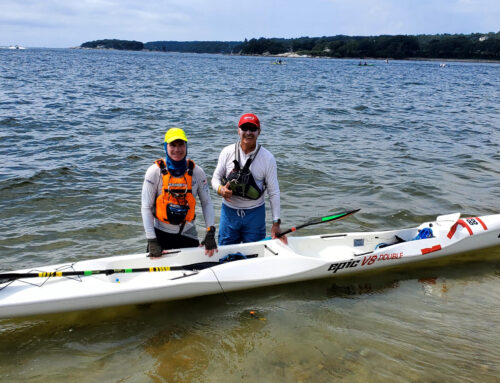
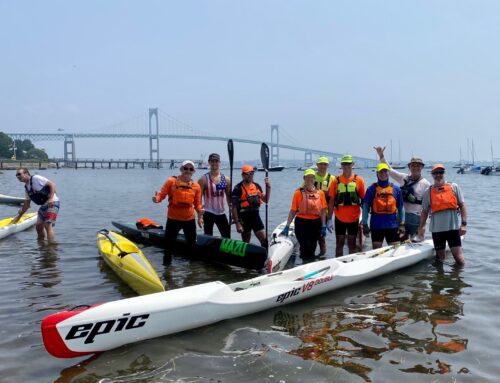
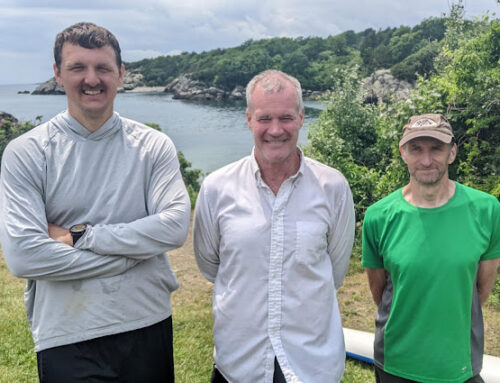
Leave A Comment
You must be logged in to post a comment.